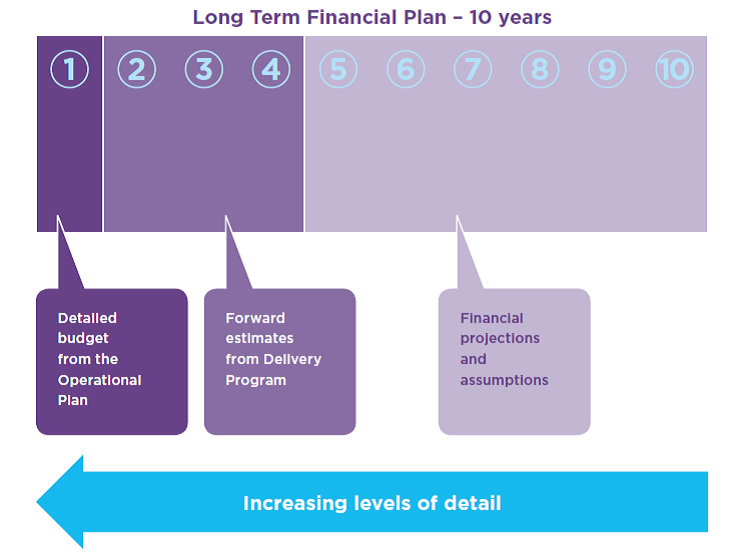The Community Strategic Plan provides a vehicle for each community to express its long-term aspirations. However, these aspirations will not be achieved without sufficient resources – time, money, assets and people – to implement them. The Resourcing Strategy is critical link when translating strategic objectives into actions.
The Resourcing Strategy consists of three inter-related elements:
- Long-Term Financial Planning
- Asset Management Planning
- Workforce Planning
The Resourcing Strategy makes clear what elements of the Community Strategic Plan the council will take responsibility for. Other levels of government, business, non-government organisations, community groups and individuals will also have a role in achieving the outcomes of the Community Strategic Plan.
As its name suggests, each of the elements of the Resourcing Strategy also play a role in resourcing the achievement of the Delivery Program and Operational Plans, as well as any other strategic plans the council has developed to support the achievement of the Community Strategic Plan.
The ‘Resourcing Strategy’ chapter of the Integrated Planning and Reporting Handbook for local government in NSW provides further information.
The Resourcing Strategy consists of three inter-related elements
-
Long Term Financial Planning
Financial Planning
The Long-Term Financial Plan must project financial forecasts for the council for at least ten years, and be updated annually as part of the development of the Operational Plan. The Long-Term Financial Plan must be used by the council to inform its decision-making during the finalisation of the Community Strategic Plan and the development of the Delivery Program.
The Long-Term Financial Plan must be structured to include:
- projected income and expenditure, a balance sheet and cash flow statement
- planning assumptions that were used in the Plan’s development
- a sensitivity analysis which highlights the factors and assumptions most likely to impact on the Plan
- financial modelling for at least three different scenarios, for example the planned scenario, an optimistic scenario (eg taking into account a yet-to-be-approved special rate variation) and a conservative scenario
- methods of monitoring financial performance.
Better practice hint:
A number of councils ensure that the projected income and expenditure spreadsheet of the Long-Term Financial Plan is available at all council meetings. Any proposed variations to the adopted budget are input into the spreadsheet so that the short and long-term consequences of the expenditure can be demonstrated. This includes not just the one-off expense that may be being proposed, but the workforce costs, and lifecycle maintenance and renewal costs that might be associated with the proposal.
Such practice ensures that councillors are able to make fully informed decisions, and understand the importance of the Resourcing Strategy documents to that decision-making.
The ‘Resourcing Strategy’ chapter of the Integrated Planning and Reporting Manual provides further information and good practice examples.

-
Asset Management Planning
A council’s asset management is supported by three key documents:
- an asset management policy – endorsed by the council.
- an asset management strategy – that identifies assets that are critical to the council’s operations and outlines risk management strategies for these assets. The Strategy must also include specific actions required to improve the council’s asset management capability and projected resource requirements and timeframes.
- asset management plans – for all assets under a council’s control, which identify asset service standards and contain long-term (at least 10 years) projections of asset maintenance, rehabilitation and replacement costs. These costs should then be reflected in the Long-Term Financial Plan.
When undertaking its asset management planning, a council will review its assets to determine that they are fit for purpose: that is, that they support the council’s achievement of the Delivery Program, and community goals and outcomes identified in the Community Strategic Plan.
If an asset solution is proposed in the Delivery Program, all elements of the Resourcing Strategy should be adjusted to include the financial, workforce and asset resources required to implement the asset solution.
The ‘Resourcing Strategy’ chapter of the Integrated Planning and Reporting Manual provides further information and good practice examples.
-
Workforce Planning
Councils are required to undertake workforce planning to support the achievement of the Delivery Program. The Workforce Management Strategy is also a four-year plan, addressing the human resources required to achieve the activities identified in the Delivery Program. Click here for workforce planning.
A council’s workforce planning should consider what people, with what skills, experience and expertise are required to implement the Delivery Program. It provides an opportunity every four years to plan adjustments to the workforce to meet changing priorities and take into account new technologies.
The Workforce Management Strategy should address issues such as:
- an ageing workforce
- succession planning
- how to provide opportunities to create and retain positions for local young people
- incentives and other programs that will support the council to be an employer of choice
- learning and development
- performance management
- recruitment strategies to fill skills gaps
- workforce diversity
- workforce planning
